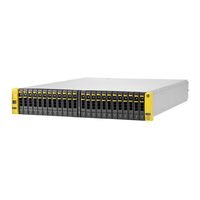HP 3PAR StoreServ 7400 4-node Manuals
Manuals and User Guides for HP 3PAR StoreServ 7400 4-node. We have 9 HP 3PAR StoreServ 7400 4-node manuals available for free PDF download: Administrator's Manual, Manual, Service Manual, Installation And Setup Manual, Instructions Manual
HP 3PAR StoreServ 7400 4-node Administrator's Manual (204 pages)
HP 3PAR Command Line Interface Administrator's Manual: HP 3PAR OS 3.1.2 (QR482-96525, September 2013)
Table of Contents
Advertisement
HP 3PAR StoreServ 7400 4-node Manual (107 pages)
HP 3PAR Web Service API 1.2 Developer's Guide (QR482-96192, June 2013)
Table of Contents
HP 3PAR StoreServ 7400 4-node Manual (95 pages)
HP 3PAR StoreServ Storage Concepts Guide (OS 3.1.2 MU2) (QR482-96384, June 2013)
Table of Contents
Advertisement
HP 3PAR StoreServ 7400 4-node Manual (63 pages)
HP 3PAR StoreServ 7000 SmartStart 1.2 User's Guide (QL226-96854, June 2013)
Table of Contents
HP 3PAR StoreServ 7400 4-node Manual (59 pages)
HP 3PAR SmartStart 1.1.1 User's Guide (QR482-96124, May 2013)
Table of Contents
HP 3PAR StoreServ 7400 4-node Manual (65 pages)
HP 3PAR-to-3PAR Storage Peer Motion Guide (OS 3.1.2 MU2) (QL226-97008, June 2013)
Table of Contents
HP 3PAR StoreServ 7400 4-node Service Manual (66 pages)
HP 3PAR StoreServ 7000 Storage Service Guide (QR482-96503, September 2013)
Table of Contents
HP 3PAR StoreServ 7400 4-node Installation And Setup Manual (35 pages)
HP 3PAR Policy Server Installation and Setup Guide (QR483-96004, December 2012)
Table of Contents
HP 3PAR StoreServ 7400 4-node Instructions Manual (9 pages)
HP 3PAR Service Processor Software Rebuild Instructions (QR483-96009, December 2012)
Table of Contents
Advertisement








